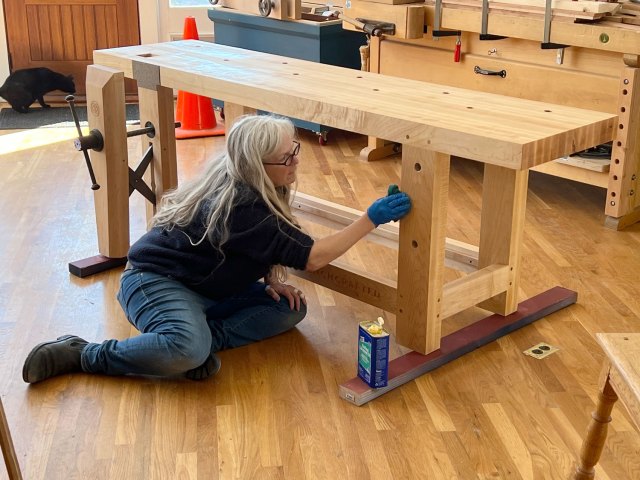
I get asked (a lot) why there are so few stick chairs in the furniture record of the United States.
To that question, I reply, “Just you wait.”
Ever since I built my first stick chair in 2003, my aim has not been to reproduce the chairs I adore from Wales, Scotland, Ireland and Sweden. Instead, my goal has been to do what Americans have long done with furniture forms and other cultural movements: Adapt them to this continent and its people.
Black Americans took an African call-and-response form of music and made the blues (then rock ‘n’ roll). Rural Americans – black and white – melded African and Spanish instruments (the banjo and guitar), with spirituals and traditional British songs to make “hillbilly music” and “race music” – what we now call country music and rhythm and blues.
All cultures adopt and adapt elements from “away,” but Americans seem particularly prone to it. We even export our adaptations back across the oceans. In Naples, Italy, anyone can buy pizza topped with hot dog chunks and french fries.
Now before you start calling me “Jingo” Schwarz, know that I don’t think everything Americans do is good. Not even close. We took the éclair and made Twinkies. The baguette became Wonder Bread. It’s a mixed bag of vanilla soft serve and Vanilla Ice.

Wait, Isn’t This a Woodworking Blog?
In the world of furniture, American designers and woodworkers tended to simplify forms brought over from Great Britain, the European continent and elsewhere. To be clear, there were American woodworkers who equaled the ornamentation and excess of their counterparts across the Atlantic. But in general, American interpretations removed ornament, simplified overall forms and relied more heavily on the solid timber that was the greatest resource of this continent.

A long day’s walk down King Street in Charleston, S.C., lays out this story that played out in the 18th and 19th centuries. King Street is awash in antiques stores that specialize in British and European antiques. And there are other stores that specialize in American antiques – plus all the house museums that are stuffed with American and imported furniture.
This long stroll (it will take you all day) also shows what the market has decided, whether you agree with it or not. My father would buy English chests of drawers on King Street in the 1990s for $1,200. The American ones were entirely out of his financial reach.


Finally, to Chair Stuff
British Forest Chairs (aka Windsors) also faced the same story. American forms are – in general – simpler. Simpler turnings. No backsplat. Fewer carved elements. (I must add, however, that my favorite Forest chair of all time is British.)


When it comes to stick chairs, my goal has always been to Americanize them. (I’ve built only a couple close copies of antique Welsh chairs – mostly to prove I could do it.) What does this Americanization entail?
First, I have changed my designs to reflect the wood we have here. Unlike Wales, we have enormous stands of straight timber. The curved stuff – which the Welsh use for arms and combs – exists here, but it’s more difficult to find. During my two visits to Wales, a walk among the hedgerows revealed a dozens of bent armbows. So my arms are different. They’re built differently, and you will see further changes in future designs.

I also tend to favor crisp lines over curved ones. All beautiful and well-worn antiques suffer “erosion,” for lack of a better word. But I try to take that crispness or clarity a little further. I avoid rounded and pillowed profiles for the most part. I like facets. I don’t like turned, round or bulbous components.
I also tend to favor geometry that is more dramatic. Many Welsh chairs had dramatic rake and splay. But a lot of them had little rake or splay. Many had sticks that were dead-vertical. I try to take the dramatic bits and pieces from old chairs and combine them into something else. I won’t say it’s new, as there is no such thing.
I also like color and grain. I am happy to paint my chairs a vibrant color or use an oil and beeswax finish on them. I am dead certain that many old chairs got flashy paint jobs back in the day or a finish that was mostly soot and smoke from the hearth. So my finish choices stand in contrast to what the old chairs look like today.
Why am I telling you this? Well, in some small way, I know that the Welsh get irritated when someone builds one of my chair designs and calls it a “Welsh Stick Chair” on Instagram or Facebook. In truth, they are building an American Stick Chair designed by a guy who dreams of Welsh, Scottish and Irish chairs all the time. So if you want to avoid a Welsh invasion of Kentucky, I recommend you call your stuff what it is: American.
Also, I want to start a conversation about this form and what it could become. I hope that other American makers will look at 11,564 old chairs and see different details that could make up a vocabulary for American stick chairs. Because there isn’t an “American Stick Chair” yet, there is enormous opportunity to explore this idea and contribute to something that just might have some legs.
— Christopher Schwarz














